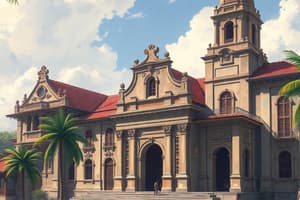Podcast
Questions and Answers
What is the primary purpose of CamScanner?
What is the primary purpose of CamScanner?
- To edit videos.
- To enhance photographs.
- To scan documents and convert them into digital formats. (correct)
- To create presentations.
Which feature is likely not found in a document scanning app like CamScanner?
Which feature is likely not found in a document scanning app like CamScanner?
- Document sharing options.
- Optical character recognition (OCR).
- Video editing tools. (correct)
- Cloud storage integration.
Which of the following best describes how CamScanner transforms scanned images?
Which of the following best describes how CamScanner transforms scanned images?
- It provides only basic image adjustments.
- It enhances the brightness and contrast of images.
- It compresses images for faster loading.
- It converts scanned images into editable text format. (correct)
In terms of document organization, which feature would you least expect CamScanner to provide?
In terms of document organization, which feature would you least expect CamScanner to provide?
What type of documents is CamScanner primarily used for?
What type of documents is CamScanner primarily used for?
Flashcards
CamScanner app
CamScanner app
A mobile application for scanning documents.
Document scanning
Document scanning
Converting physical papers to digital files.
Mobile app
Mobile app
Software designed to run on smartphones or tablets.
Digital format
Digital format
Signup and view all the flashcards
Scanning documents
Scanning documents
Signup and view all the flashcards
Study Notes
The History of Civil Engineering in the Philippines (Spanish Era)
- Civil engineering in the Philippines was synonymous with architecture during the Spanish era
- No Filipino civil engineers existed during this time
- Filipinos were limited to being called "Maestro de Obras" (Master Builders)
- Master Builders were equivalent to Construction Foremen
- Civil engineering wasn't recognized as an academic discipline
- Only Spanish architects/engineers held academic degrees
- Intramuros (walled city) was built by Spaniards as a model community
- Filipino engineers were responsible for maintaining and repairing infrastructure, including churches, convents, and government buildings
- Filipino engineers worked for the elite (Ilustrados)
- Miguel Lopez de Legaspi founded the City of Manila on June 24, 1571
- The establishment of the City of Manila was followed by the building of Fort Santiago (Fuerte de Santiago) in 1571
Further History of Civil Engineering
- Fort San Antonio Abad was built and captured by the British in 1762 and later rebuilt
- Fort Santiago was a significant historical site in Manila, used for imprisonment
- The Puente Grande, a wooden bridge, was the first bridge across the Rio del Pasig
- This bridge connected Intramuros and Binondo, making travel faster.
- Puente Colgante, a suspension bridge, was the first in Southeast Asia, built from 1849 to 1852. This bridge stretched 110 meters long and 7 meters wide.
- Irrigation and water systems were developed by the Spaniards, including artesian wells in Betis, Pampanga
- The Pasig River Light House was the first masonry-built lighthouse in the Philippines, built in 1846, but decommissioned in 1992.
- The Philippines' first suspension bridge was built in 1852.
- Additional projects included the construction of public works structures such as the churches, convents and public buildings after the initial founding of Manila.
Studying That Suits You
Use AI to generate personalized quizzes and flashcards to suit your learning preferences.




